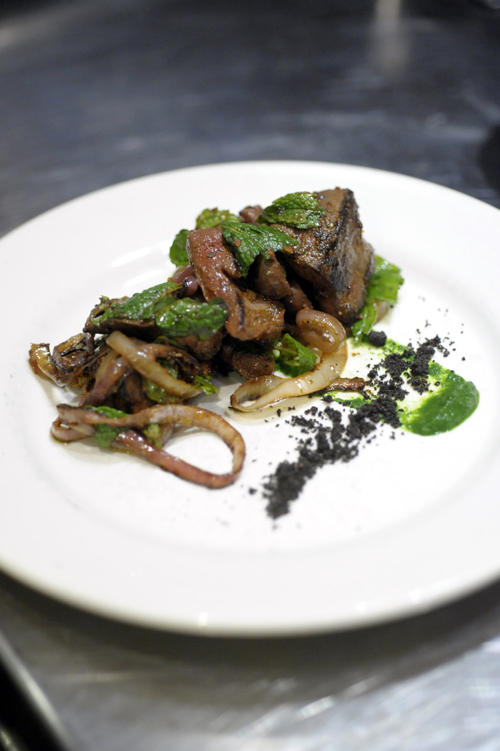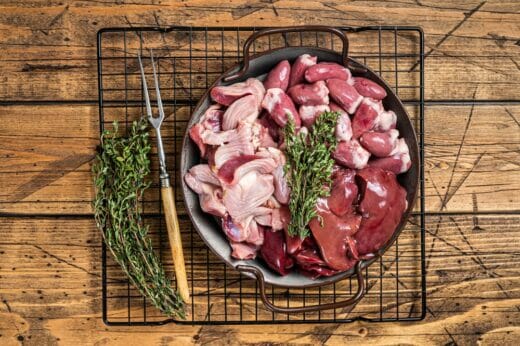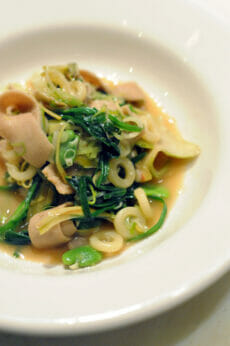Offaly Delicious: Can the US Learn to Love Organ Meats Again?
For many looking to eat more sustainably, reducing their meat consumption is often the first step. But what if increasing certain types of meat eating made a bigger difference?
Offaly Delicious: Can the US Learn to Love Organ Meats Again?
For many looking to eat more sustainably, reducing their meat consumption is often the first step. But what if increasing certain types of meat eating made a bigger difference?

Prepared lamb pluckby Michael Harlan Turkell
If you want to eat more sustainably, the answer seems obvious, according to researchers at the University of Oxford: Go vegan—or at least eat vegetarian as much as possible. Avoid animal products. Get your protein and your iron and your B12 elsewhere. Stock your fridge with tofu, tempeh and beans, and forgo the trip to the meat counter at your local grocery store completely.
Experts agree that limiting meat consumption or avoiding it altogether is the best way for individuals to reduce agricultural emissions that largely come from the rearing of livestock. But it’s not the only solution. Eating meat could actually be a way to cut emissions—if we’re eating the right kinds of meat, of course.

Offal, or organ meats, can be a solution for sustainability-minded meat lovers. One 2019 study showed that if everyone in Germany decided to incorporate offal into their diets in place of other types of meat once or twice a week, the country could reduce livestock emissions by up to 14%. That’s because, despite many Western countries’ love of meat, a lot of the animal protein produced is wasted. Due to a lack of demand for organ meats, much of it is trashed or sent to rendering, a process that converts unused animal tissue into usable ingredients for products such as paint, soap, candles and fertilizer. And because animal agriculture is so resource-intensive, we end up wasting an incredible amount of energy and resources every time a liver, kidney or stomach ends up in a bin instead of on our plates.
At Walden Local Meat Co., a whole-animal share program located in Boston, MA, employees try to educate consumers about the sustainability and health benefits of choosing offal over other types of meat. “We’re trying to raise more awareness of it,” says Kristen Kilfoyle Boffo, director of strategic partnerships at Walden. “It’s just not something [people are] used to as an option.” Despite the popularity of their butcher’s blend of beef liver, heart and kidney, some of the organ meats they process still end up at a rendering facility. Not only does Walden not make a profit off of this meat, it actually has to pay for the rendering itself. “It’s just the cost of doing business,” says Kilfoyle Boffo. The offal it does sell goes for considerably less than the most popular cuts of meat it offers. For example, at the time of writing, Walden’s beef brisket was on sale for $12.99 per pound versus beef liver for $3.49 per pound and beef kidney for $1.99 per pound.

In much of the world, organ meats are regularly enjoyed, even prized. But, according to Chris Cosentino, chef and author of Offal Good: Cooking From the Heart, with Guts, the US’s sordid history with these cuts of meat has affected our perceptions of them. “In the US, offal fell out of favor after WWII,” he explains. “There had been scarcity during the war, and people had to rely on the cheaper cuts. People who survived on rationing stamps during the war were forced to eat offal, as it was more readily available as meat was rationed. After the war, offal was viewed as the food of the poor.” This association with poverty, with lack, has cast a shadow on offal’s popularity for decades, rendering these cheaper cuts largely undesirable to those who want to distinguish themselves from the poor. More expensive offal dishes do not seem to suffer the same fate; foie gras and pâté, for example, are often associated with luxury and fine dining in a way that liver and onions isn’t.
Even beyond the historical context of offal consumption in the US, though, organ meats may be unappealing to some because they’re recognizable as body parts that humans also have. “In our minds, most people have a direct correlation to [themselves] when [they] see these meats: brains, liver, spleen. We all have these organs, so it becomes very unsettling for many people,” says Cosentino. Of course, we all know that the meat we buy is animal flesh, but the chopped-up skeletal meat many of us are used to looks less like body parts we readily recognize than hearts, kidneys or livers do. Perhaps we’re hesitant to think too deeply about the fact that our meal was once a living being not dissimilar to ourselves.
Additionally, many of us have become more and more disconnected from our food system. “Most of us just walk about supermarkets and pick stuff off of the shelves rather than being involved in the production of food, so when something as far removed as organ meats is suggested, it just isn’t even considered,” says Sam Feltham, director of the Public Health Collaboration, a UK-based non-profit that created Organuary, which encouraged people to enjoy more offal during the month of January to minimize food waste and improve their nutrition.

But it may be time to get rid of our hang-ups regarding offal. Not only can offal be a more sustainable choice, in many cases, offal meats are actually more nutritious than their skeletal meat counterparts. Liver in particular provides significant amounts of iron, a mineral in which many Americans are deficient.
Beyond the sustainability and health benefits of eating offal, these cuts of meat hold tremendous culinary potential as well. “Offal offers a broader flavor and texture experience,” says Cosentino. Many cultures discovered the joys of well-cooked offal long ago; dishes such as Korean seolleongtang, a beef soup that contains various organ meats, and Spanish oreja de cerdo, crispy pig ears served as tapas, highlight just how enjoyable offal can be when it’s treated with intention and care in the kitchen.

But there is hope yet for offal’s popularity in the US. As interest in global cuisines grows, Americans may have more access to, and awareness of, offal dishes from cultures other than their own, perhaps inspiring them to incorporate these meats into their diets in new, delicious ways. “We do hold the keys to introducing [offal] to people,” says Ron Abell, senior executive chef at Fenway Park, the infamous Boston baseball field. Abell often works offal meats into his buffets, exposing his guests to cuts with which they may not have been acquainted before. “[People] are amazed at it.”
Teaching consumers how to prepare offal in their own kitchens is important, too. Walden Local Meat Co. offers recipes for home cooks newer to using offal. Even if organ meats don’t seem immediately appealing, home cooks can easily tap into those health and sustainability benefits by breaking the cuts down into more manageable consistencies. “A good place to start is to add blended liver or kidneys to dishes you already cook, such as bolognese or cottage pie—that’s how I sneak it into my children’s food,” says Feltham.
In the US, offal can be polarizing, but it doesn’t have to be. This country has embraced offal before, and it can again. Of course, choosing beef liver over a prime rib isn’t single-handedly going to undo the environmental harms caused by our wasteful food system, but creating demand for a more sustainable type of meat could be a single step in the right direction.
Follow us

This work is licensed under a Creative Commons Attribution-NoDerivatives 4.0 International License.
Want to republish a Modern Farmer story?
We are happy for Modern Farmer stories to be shared, and encourage you to republish our articles for your audience. When doing so, we ask that you follow these guidelines:
Please credit us and our writers
For the author byline, please use “Author Name, Modern Farmer.” At the top of our stories, if on the web, please include this text and link: “This story was originally published by Modern Farmer.”
Please make sure to include a link back to either our home page or the article URL.
At the bottom of the story, please include the following text:
“Modern Farmer is a nonprofit initiative dedicated to raising awareness and catalyzing action at the intersection of food, agriculture, and society. Read more at <link>Modern Farmer</link>.”
Use our widget
We’d like to be able to track our stories, so we ask that if you republish our content, you do so using our widget (located on the left hand side of the article). The HTML code has a built-in tracker that tells us the data and domain where the story was published, as well as view counts.
Check the image requirements
It’s your responsibility to confirm you're licensed to republish images in our articles. Some images, such as those from commercial providers, don't allow their images to be republished without permission or payment. Copyright terms are generally listed in the image caption and attribution. You are welcome to omit our images or substitute with your own. Charts and interactive graphics follow the same rules.
Don’t change too much. Or, ask us first.
Articles must be republished in their entirety. It’s okay to change references to time (“today” to “yesterday”) or location (“Iowa City, IA” to “here”). But please keep everything else the same.
If you feel strongly that a more material edit needs to be made, get in touch with us at [email protected]. We’re happy to discuss it with the original author, but we must have prior approval for changes before publication.
Special cases
Extracts. You may run the first few lines or paragraphs of the article and then say: “Read the full article at Modern Farmer” with a link back to the original article.
Quotes. You may quote authors provided you include a link back to the article URL.
Translations. These require writer approval. To inquire about translation of a Modern Farmer article, contact us at [email protected]
Signed consent / copyright release forms. These are not required, provided you are following these guidelines.
Print. Articles can be republished in print under these same rules, with the exception that you do not need to include the links.
Tag us
When sharing the story on social media, please tag us using the following: - Twitter (@ModFarm) - Facebook (@ModernFarmerMedia) - Instagram (@modfarm)
Use our content respectfully
Modern Farmer is a nonprofit and as such we share our content for free and in good faith in order to reach new audiences. Respectfully,
No selling ads against our stories. It’s okay to put our stories on pages with ads.
Don’t republish our material wholesale, or automatically; you need to select stories to be republished individually.
You have no rights to sell, license, syndicate, or otherwise represent yourself as the authorized owner of our material to any third parties. This means that you cannot actively publish or submit our work for syndication to third party platforms or apps like Apple News or Google News. We understand that publishers cannot fully control when certain third parties automatically summarize or crawl content from publishers’ own sites.
Keep in touch
We want to hear from you if you love Modern Farmer content, have a collaboration idea, or anything else to share. As a nonprofit outlet, we work in service of our community and are always open to comments, feedback, and ideas. Contact us at [email protected].by Samantha Maxwell, Modern Farmer
August 1, 2023
Modern Farmer Weekly
Solutions Hub
Innovations, ideas and inspiration. Actionable solutions for a resilient food system.
ExploreShare With Us
We want to hear from Modern Farmer readers who have thoughtful commentary, actionable solutions, or helpful ideas to share.
SubmitNecessary cookies are absolutely essential for the website to function properly. This category only includes cookies that ensures basic functionalities and security features of the website. These cookies do not store any personal information.
Any cookies that may not be particularly necessary for the website to function and are used specifically to collect user personal data via analytics, ads, other embedded contents are termed as non-necessary cookies.
I’ve enjoyed delicious dishes: sweetbreads, heart kabobs, lingua tacos or pickled tongue sandwich meat. Liver and onions, chopped liver spread. Kishka! Menudo! so many good things. But why do we call it “offal”? It sounds too much like “awful”!
Love this article! Being Eastern European, my mother cooked the family, not only liver and onions (yum!), but we had chicken heart, liver and gizzards. She would put the gizzards and liver in the stuffing for Thanksgiving. Simply delicious! She also made liver dumplings! Fantastic in her chicken soup. We also ate beef kidneys. Unfortunately my husband was never brought up with eating these parts and, if I make something with chicken hearts, liver or gizzards, I have to eat it myself, but that’s no problem. I tell him he doesn’t know what he’s missing!
Kidneys taste offal.